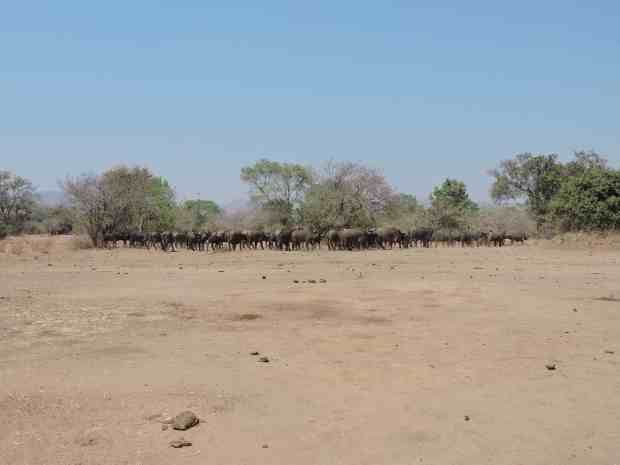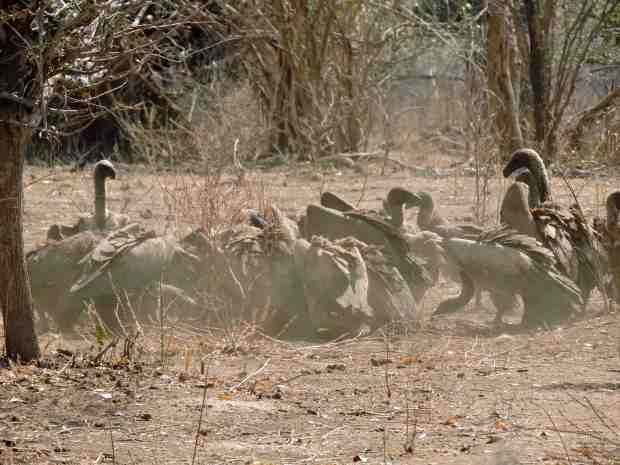
General views of the Chitake springs
We returned to the Chitake springs in the Zambezi valley exactly three years since our first visit [1]. This time we went alone, my wife and I and, luckily again, we managed to secure the very sought after Campsite 1 (we booked it one year ahead of time!).

Aware of the “fun nights” that you spend in this amazing place, we prepared ourselves for any eventuality taking our “heavy duty” tent and planned to park our car near one of its entrances as our emergency exit, following the advice of our son, a bit worried about the “oldies” being alone in the wilderness!
The Chitake river with its springs is one of the wildest areas left in Southern Africa. There are only two campsites open to the public (although we learnt that a third campsite can be booked at Nyamepi in Mana Pools). There is also a campsite for tour operators near Chitake 1. This arrangement ensures that you are unlikely to see many people around! In addition, most of the exploring is done on foot so no much driving needed either.

The fact that water seeps from the ground on a daily basis supports a population of game animals that dwell nearby. There are numerous buffalo, zebra, greater kudu and impala that in turn feed predators such as painted dogs, hyenas, leopards and lions. In addition there is a substantial elephant presence that files daily along the dry riverbed towards the water source.

Buffalo at Chitake.
Campsite 1 is about two metres from the usually dry river bed and to be there waiting for “events” is an unforgettable experience that not all are prepared to take. We have camped all our lives and taken precautions in Kenya and other “open” camping places.

The access to the river from Chitake 1.
We did not feel endangered and we knew that the only possible cause of problems would be the lions that were present in the area and we know that they respect tents. Our main concern was about the time you spend at camp in the dark as the camp is surrounded by thick bush. In particular nocturnal physiological needs were a worry as we needed to reach our long drop a few metres away!

Our possible nocturnal target…
We arrived in the afternoon and spent some time to locate our camp in a spot as safe as we thought possible within the camping area.

Considering the camping options.
As we had food already prepared, we were in for an early night. We set up our camera trap to “see” what was lurking in the dark around us and went to sleep. The night passed off rather calmly at camp although we heard the elephants walking nearby on the way to the water and the hyenas calling early during the night. We were probably tired and sleep came easily.

The camp. The car was kept near the tent exit.
We were up early the following morning and all appeared well. We checked the camera trap and confirmed that there was life around our camp.
After that we decided to have breakfast prior to a short game drive as there are not many roads around the area. Then we noted that our 5-litre water container had disappeared! It was one of these supermarket transparent bottles that we had as a back-up in addition to the 40lts we had brought as Chitake does not offer any.
Although we searched the surrounding area, we failed to find the bottle! We could only speculate on the possible culprits. We discarded human interference, as thieves would steal more valuable stuff from the camp. We rejected the baboons as they do not move at night. That left us with the hyenas as the possible culprits. We heard them and saw their footprints at camp. In addition, we had had encounters with them earlier in Kenya and they can get very cheeky! We decided that the latter were likely to be the culprits but the enigma remains.
Our short morning drive took us to a bunch of vultures feeding on the remains of an impala that had clearly been killed earlier that morning. About twenty White-backed were scuffling for the few remaining meaty bits while a couple of Lappet-faced waited for their time to tackle sinews, tendons and the like.

The rest of the day remained peaceful, contemplating the various animals coming down to drink at the springs from our camp chairs located at the riverbed that -luckily had good shade. While there we were assaulted by tabanids and tsetse flies so we needed to use large amounts of repellent and still we got hammered!

My wife contemplating the springs from the shady riverbed.

Tsetse and other biting flies collected from the floor of the car.
Hundreds of impala came to drink in the morning and they were joined by small groups of greater kudu and zebra. When we saw a large dust cloud rising behind the gorge where the springs are, we knew that the buffalo had arrived and they were soon at the springs satiating their thirst. Quite a sight!

A herd of impala in the distance (the shadow at the back that looks like a predator is in fact a baboon)

After the dust settle we could see the buffalo drinking.
As usual the day went fast and it was soon time to prepare for the evening. We were encouraged by the relative quietness of the earlier night and hoped to sleep well.
We were mistaken…
There were some early indications of trouble when, as soon as it was dark, several hyenas started to call from different places along the river. When we heard them laughing we knew that they had become excited for some reason, probably a kill although we were in no condition to discover the cause!
From the tent we started hearing elephant movement. We spotted several family groups walking rather nervously and trumpeting frequently showing that they were also nervous. As it was getting late we retired to our tent. I went to sleep soon afterwards as I have a reputation to live up to!
The next thing I remember was that something grabbed my ankle and it was shaking and pulling me! For the few hundredths of a second (or less, I do not know) that it takes to move from being sleep to some kind of alertness I thought I was a goner and that the dreaded time of being taken by a wild beast had finally come. My wife’s voice brought me back to reality: “There is a leopard there!” I muttered “Where?” thinking that it was inside the tent and taking me! I then realized that she was responsible for holding my foot on her third attempt at waking me up!
The picture soon became clear. With one hand she was keeping the torch light on the leopard through the tent window while, with her free hand, she had been shaking me for a while to alert me about the leopard sighting!
I must admit that it took me a while to recover from the severe fright and once I made sure that all my organs were functioning as expected -including my eyes- I looked where I supposed to and stared at the disappearing leopard’s eyes on the riverbed, a few metres away.
My rude awakening took place after 3 am and we were still awake listening to the sounds of the wild after an hour. I then learnt that my wife had not slept much as the leopard(s) had been calling every once in a while and she had been trying to locate them on the riverbed (from the tent of course!). In addition there were some noisy little mice digging under the tent that she tried to fend off by hitting them through the canvas as well as hearing the monotonous calls of the Fiery-necked Nightjar (Caprimulgus pectoralis) in the distance. This bird is capable of up to 110 repetitions of its call believed to say “Good Lord, deliver us” before stopping![2].
The following morning, as expected, we were not up early. After a leisurely branch we did spend time examining the abundant spoor at the riverbed but we did not detect any signs of a kill. We confirmed that the leopard(s), as my wife mentioned, had walked up and downstream. We also found plenty of hyena and painted dog spoor as well as lots of new signs of elephant over their “highway” to and from the springs.

Checking for activity and spoor at the dry river bed after the long night!

Elephant footprints next to the Bushsnob’s Croc.
The camera trap pictures showed hyenas as well as several elephants walking during the night.
Later on, while exploring the area by car, we found a group of five hyenas resting under a shade. The same as us they were suffering from sleep deprivation as they were clearly some of the culprits of the noisy night resting!


We spent the rest of the day exploring the river bed on foot and luckily, it appeared that all animals -including us- were drained from the previous night as the last night we spent at Chitake was peaceful and my wife recovered her lost sleep while I did my usual trick of instantly dozing off.
[1] See https://bushsnobinafrica.wordpress.com/2015/09/23/chitake/
[2] Roberts VII Multimedia Birds of Southern Africa. iPhone and iPad Edition. Version 2.4. Southern African Birding.














